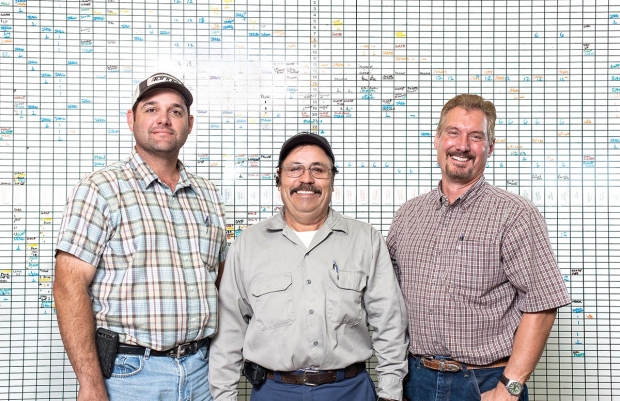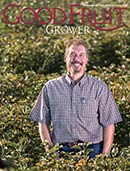
The management team of Lodi Farming, from left to right, Ray Avansino, Ezequiel Escamilla, and Jeff Colombini, stand in front of the hub of the company’s operations’a white eraser board. The board, color coded by crop, lists upcoming farming tasks that need to be coordinated. TJ Mullinax/Good Fruit Grower
Jeff Colombini believes he learns more by seeing what others are doing than staying home on the farm, using the same growing techniques his father used. That’s why he made his first trip to the Pacific Northwest 20 years ago, continues to attend Northwest cherry meetings, and why he got involved with a national apple organization.
From his travels, he’s learned new growing techniques to improve fruit size and quality, but he’s also learned that not all techniques transfer to his growing situation. “New ideas require constant testing because they may not always work under our soils and climate,” said Colombini, president of Lodi Farming Company.
2013 Grower of the Year
Denny Hayden, tree fruit grower from Pasco, Washington and previous recipient of the Good Fruit Grower of the Year award, met the California orchardist during one of Colombini’s trips to the Northwest. Hayden, a member of the Washington Tree Fruit Research Commission’s cherry committee, has become a frequent visitor to Colombini’s orchards and experimental block in Lodi, California.
“Jeff is a solid grower in both cherries and apples. He experiments a lot on his own,” Hayden said. “Through the years, we’ve
Hayden added, “He uses the latest techniques, is a student of horticulture, and very practical in an economic sense. Many of our conversations have gone like this: ‘Denny, what you’re doing is a great technique, but is it cost effective? Why are you really doing that? What is the end game? It’s made me think, yeah, why am I doing this?”
When Surround (kaolin clay film) first came out, Hayden said that Colombini was eager to use it in his apple orchards, but was having problems with application. “Jeff and his partner [Ray Avansino] designed their own sprayer to make application more effective. Jeff doesn’t sit back and wait for things to happen.”
One of the equipment projects slated for design this winter at Lodi Farming is a device that would be able to clean reflective orchard covers, such as Extenday, while the material is being rolled up in the orchard for winter storage. Colombini has had a problem of mud from their sticky, clay soils getting on the reflective covers and turning them a dingy gray, reducing the reflective properties.
Cherry research
More Stories |
| – Grower has an open door |
Colombini has attended countless Cherry Research Review meetings of the Tree Fruit Research Commission held in Washington and Oregon, said Jim McFerson, manager of the Research Commission. California cherry industry delegates regularly attend the annual research review to facilitate coordination and collaboration on research projects between the Northwest and California cherry industries.
An example of a shared project between the two industries has been ongoing research conducted by university and U.S. Department of Agriculture scientists to identify health benefits of fresh cherries. Colombini has been a California representative serving on the joint-industry health research committee.
Researchers from the two regions also are working closely together to develop control strategies for a new invasive pest, spotted wing drosophila.
In the past, Colombini said the California cherry industry was somewhat stymied in its funding of cherry research because its marketing commission, the California Cherry Advisory Board, represented only four varieties grown in the state and was greatly underfunded. About a year ago, California cherry growers approved a new commission called the California Cherry Board, discontinuing the old one.
Colombini, a past chair of the Advisory Board, serves on the board of directors for the new group and chairs its finance committee. He’s hopeful the new organization will continue its research collaboration with the Northwest and be able to provide more research funding.
“The two primary purposes of the new board are research and export issues,” he said, adding that board will avoid generic promotion of cherries. The 2013 research budget of the new board was about $300,000, more than double previous amounts spent on research.
He’s also been involved with the California Cherry Growers and Industries Foundation, a voluntary group that can be politically active. The foundation provided seed money to establish the new cherry board.
Moreover, Colombini has been involved with apple industry issues, both state and national. He is a board member of the California Apple Commission and the U.S. Apple Association.
“Jeff has a can-do, positive attitude,” said the Research Commission’s McFerson, who’s based in Wenatchee, Washington. “His collaborative nature has helped bring the Northwest and California industries together on many projects, and he works to create greater harmony for our industry.”
The management team of Lodi Farming, from left to right, Ray Avansino, Ezequiel Escamilla, and Jeff Colombini, stands in front of the hub of the company’s operationsa white eraser board. The board, color coded by crop, lists upcoming farming tasks that need to be coordinated.







Do you have any contact information available for Jeff Columbini. My sister and I are starting up beverage business and are looking for a source of cherries and other fruit such as apples. I am having a difficult time finding his contact info.
Can you help?
ThankYou
Rich Castaneda
Rich, we don’t give that out without permission. Try googling Jeff and you’ll find what you need.